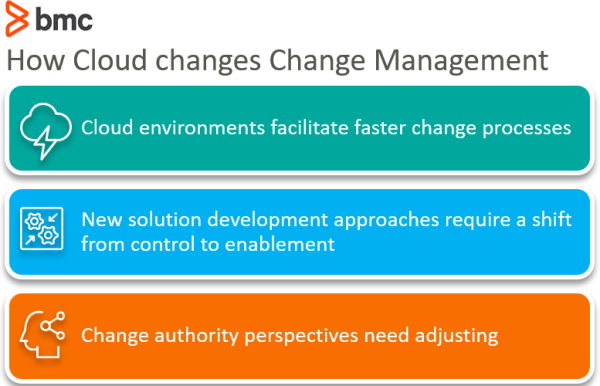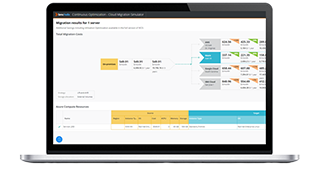Cloud technologies are now firmly established as the norm for enterprise IT. In fact, most organizations are now tying digital transformation strategies firmly to a cloud-first approach. According to Gartner, growth in enterprise IT spending for cloud-based offerings will be faster than non-cloud spending through 2022—what they term the “cloud shift”. And the drive is not just because of cost savings from a CapEx perspective, but rather value from speed in delivery of new or changed products and services, in line with the ever-changing customer needs and market dynamics.
Managing these changes to service offerings in the cloud age needs fresh thinking and a break from traditional change management. ITIL® 4 defines a change as:
The addition, modification, or removal of anything that could have a direct or indirect effect on services
Change management, then, is the process responsible for controlling the lifecycle of all changes, enabling beneficial changes to be made with minimum disruption to IT services.
Migrating to the cloud does not mean we are immune to incidents that stem from changes—you only have to look as far as Google and Facebook to see that. Instead, practices that support cloud change management should evolve appropriately to take advantage of cloud benefits. Let’s look at three considerations of change management in the cloud.

1. Cloud environments facilitate faster change processes
Cloud environments are designed for agility—facilitating speed when it comes to change. Components and licenses are available on demand. Apart from financial constraints, there is no delay that determines when you can spin up an environment with the requisite capacity and software you need for your solution. This means that changes can be made using a few clicks and operations, taking minutes rather than days. This isn’t limited to setting up new environments; replicating or rolling back changes across multiple environments is significantly easier and quicker.
Traditional IT environments require a considerable amount of planning for capacity upgrades. This is not true of cloud environments, where autoscaling ensures capacity can be upgraded automatically, on demand.
Cloud environments also provide or facilitate the use of a variety of automation, integration, and deployment tools that allow the organization to make small, frequent changes that reduce business risk and introduce business value at an increased rate. These include solutions such as:
Therefore, the cloud reduces the necessary change management effort of understanding and preparing infrastructure for required changes. Also, the automation and high velocity that characterizes changes in the cloud means that routing of changes through a centralized repository—for logging all changes for categorization, prioritization and approval—takes a back seat due to the bottleneck it could introduce.
2. New solution development approaches require a shift from control to enablement
Because approaches such as Agile and DevOps are now the mainstay of solution development in the cloud, change management needs to move from a control perspective to one of enablement. These new approaches are self-managed in nature; as such, they repel any attempts to impose bureaucratic control—a hallmark of change management. These approaches prefer iterative and regular deployment of new features and modifications, which can be delivered through continuous integration, delivery, and deployment processes. (No wonder the ITIL 4 publication quickly evolved the name of the change management practice from change control to change enablement.)
Cloud technologies, in essence, de-risk a lot of changes (in a sense turning them into standard changes). This results in the removal of a lot of complexity in the planning and execution of changes due to automation and visibility provided by these technologies.
Adoption of cloud means that change management should now be geared towards exploiting these capabilities, therefore focusing on development of appropriate change models (repeatable approaches to the management of a particular type of change, e.g. creating a container or modifying a product feature). Cloud-focused change models would consider:
- Technical aspects
- Compliance requirements (e.g. data privacy and information security controls)
- Product ownership
- Additional concerns
Defining these models upfront facilitates faster planning, approval, and automated execution of changes within the cloud environment. Low and medium risk models would be fully automated, including appropriate checks. High risk/cost changes would be automatically routed to the relevant authority for review and approval.
3. Change authority perspectives need adjusting
Traditionally, there are multiple change authorities dependent on the type of change. A change of significant cost and risk could go all the way to the board for approval, while a low-level change might just require the data center manager.
One well known authority in IT changes is the Change Advisory Board (CAB), which became the de facto target for bureaucracy in change management, where their decision-making process was not organized to support speed in delivery of business value through change. This approach is counterproductive in a cloud environment, as the thinking should not be on stopping changes on the whims of subjective analysis—rather on facilitating quick execution.
To facilitate speed in a cloud environment, product and infrastructure teams must have greater autonomy in prioritizing what changes should be executed. Control is only exercised, then, where risk and cost are beyond the set thresholds. So long as the team is within thresholds and based on the agreed models, freedom to execute changes is granted. Rather than having a centralized external CAB, internal peer reviews become the preferred authority on decision making for changes to code or environments. This reflects the internal self-managed capability instead of reliance on external authority, as Google explains.
So, in a cloud environment, the visibility of change becomes the main focus for higher level change authorities who are outside the product or infrastructure teams. These authorities can utilize cloud monitoring dashboards to track:
- What changed
- Whether compliance requirements are met
- Metrics, especially those indicative of velocity of changes such as percentage of changes that are fully automated
Higher level change authority also comes into play whenever a change causes a major incident, championing root cause analysis and ensuring appropriate corrective action is integrated into the automated change workflows. This macro-level change authority will also coordinate and integrate the teams who manage cloud environments and the teams developing products.
The cloud changes change management
The best way to sum up how the cloud affects IT service delivery is that it changes everything—including, of course, how we manage change.
Additional resources
For more on change management and cloud complexity, explore these BMC Blogs:







